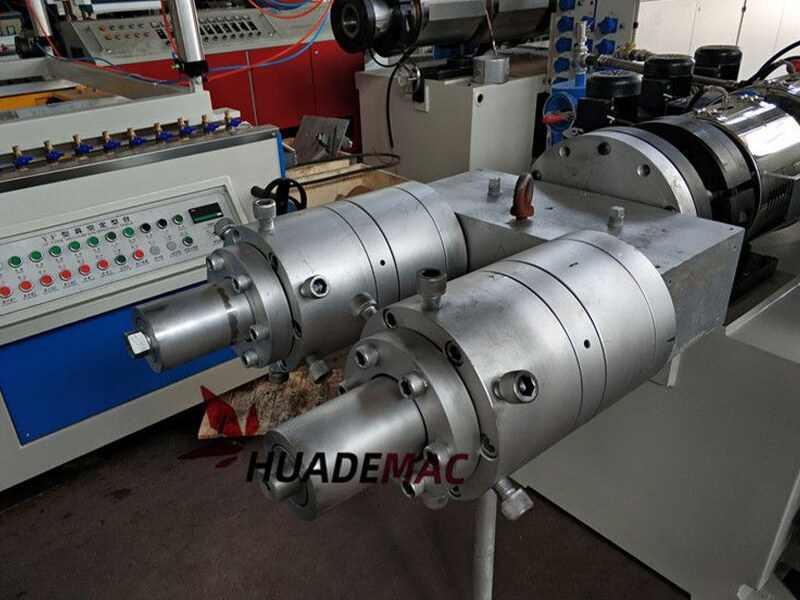Manufacturer of pipe technology solutions
- Any Questions?[email protected]
- Get in Tough+86-13601562675

The spiral mandrel die is also called the spiral split fluid die. For the spiral splitter die, the melt flow entering the die first passes through the splitter system—some are several star-shaped holes or other splitter systems, and splits around the die. The melt then enters a runner that spirals around the mandrel. The depth of the spiral channel gradually decreases as it approaches the outflow end of the die. At the same time, the gap between the core mold and the cavity of the die body gradually increases. In this section, an overlap of axial and radial flows occurs within the stream. Along the outflow direction of the die, the proportion of radial flow decreases, while the proportion of axial flow continues to increase, and finally all the melt flows along the axial direction. In this way, the flow imprint of the sub-fluid channel is evenly distributed along the circumference of the pipe section, which means that no local strength loss occurs.
The quality of the melt distribution around the pipe section is influenced by many factors. These factors include the geometric dimensions of the die, such as the number of runners, the twist angle of the runners, the pitch of the helix, the depth and width of the groove, the gap width, the raw material being processed, especially its viscosity, and the extrusion volume and material temperature. With the help of computer programs and operator experience, the spiral splitter can be optimally designed to suit a specific range of applications. In this case, the wall thickness distribution is very uniform. In addition to eliminating the material line, this kind of die has advantages in the following aspects:
1. The mechanical stress and thermal stress are low, and the products have good mechanical strength.
2. The structure is solid, so it is suitable for extrusion of high-viscosity materials, and the assembly and disassembly of the die head is easy to operate.
3. It is easy to drill holes on the mandrel, so it is easy to use the internal cooling system.
The above advantages make the spiral mandrel die head more and more widely used.
The disadvantage of this type of die is that due to its relatively complex structure, this type of die is sensitive to changes in the raw material. Even small changes in viscosity and rheological properties can change the flow conditions in the helix, and changes in pipe diameter have a similar effect. Therefore, it is necessary to design the geometry of the spiral so that the die head has the widest possible processing range to accommodate different materials and extrusion volumes.
On a basket die, the stream first passes through a bracket or a stream distribution system with multiple star holes. The melt then flows through the porous section. This element, the screen basket, does not flow through it axially, but radially from the inside to the outside. Because the screen basket has a certain length, it provides a large flow area in the case of a small diameter of the machine head. Thus, at relatively small die sizes, the pressure in the porous section is reduced. In the basket section, the melt flow changes direction twice and then becomes axial. The individual streams can be well mixed, and the melt is more homogeneous.
Merging between streams is achieved with the aid of a retarding element and adjacent slack buffers. Due to the relatively large cross-sectional area of the sieve basket, the head pressure of the sieve basket type head is significantly lower than that of other structural forms. The load on the material is relatively small, and the temperature of the material is relatively low, which can easily increase the extrusion capacity. The biggest advantage of this type of machine head is that it has good adaptability and can achieve good homogenization even at high extrusion rates; the change of pipe diameter and wall thickness, the type of PE raw material, material viscosity, back pressure Under the change, can produce high-quality pipes. The biggest disadvantage of this type of die head is that the fusion of all materials in the die head, cleaning during production, and disassembly of the die head are not as good and convenient as the spiral mandrel type die head.
In short, these two die heads have their own advantages and disadvantages. It is recommended to learn from each other and choose according to your own production conditions when purchasing PE pipe die heads. The grades of raw materials are not fixed, and the production volume is large. When the pipe color is not changed frequently and the die head is cleaned and disassembled, it is best to use a sieve basket die head. It is required that the wall thickness of the pipe is relatively uniform, and the grade of the production raw material is relatively fixed. When the color of the pipe is often changed and the die is cleaned and disassembled, it is best to use the spiral mandrel die.